Traditional handcrafted cleansers combine carrier oils like castor and sunflower with therapeutic botanicals. You'll find powerful ingredients in aloe vera, chamomile, and tea tree oil that calm, protect, and heal your skin. Create effective formulations by infusing herbs into oils, adding natural emulsifiers, and balancing the pH between 4.5-5.5 to support your skin's acid mantle. Start with simple recipes using cold-pressed oils before advancing to more complex blends. These ancient ingredients hold secrets modern skincare often overlooks.
The Therapeutic Benefits of Botanical Cleansers
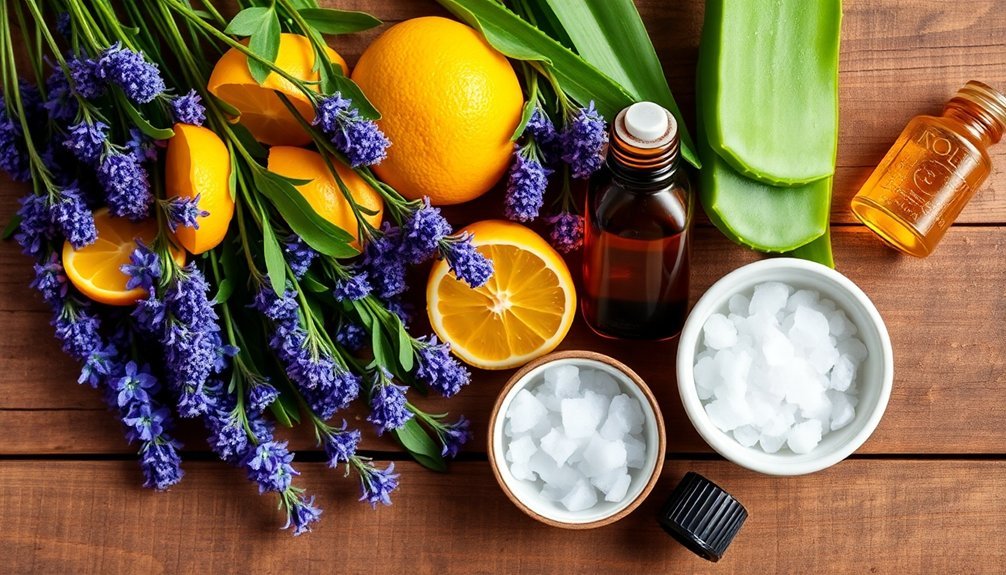
When exploring the domain of botanical cleansers, you'll discover a treasure trove of natural ingredients working together to transform your skincare routine.
These formulations offer far more than simple cleaning power. Botanical cleansers deliver multiple therapeutic benefits simultaneously. Aloe vera and chamomile calm irritated skin, while tea tree oil and lavender provide antimicrobial protection. Exfoliating botanicals like pumpkin and papaya enzymes naturally resurface the skin by removing dead cells.
For those struggling with inflammation, witch hazel reduces redness and soothes sensitive areas. Your skin's moisture barrier remains protected through hydrating components like coconut and argan oils.
Meanwhile, ingredients such as rosehip oil and purslane stimulate collagen production for improved regeneration. The aromatherapeutic properties of lavender, chamomile, and rose geranium essential oils enhance your cleansing experience, lifting your spirits while supporting your skin's natural balance and health.
Crafting Oil-Based Cleansers With Traditional Herbs
The art of crafting oil-based cleansers connects us to ancient skincare traditions while harnessing nature's potent ingredients. You'll need carrier oils like castor oil for its antimicrobial properties, sunflower oil for lightweight penetration, and camellia oil rich in antioxidants. These serve as your base for infusing traditional herbs. Modern formulations like Blinking Owl Acres' Herbal Oil Cleanse demonstrate how deep cleansing benefits can be achieved while maintaining skin balance.
| Oil Base | Herbal Addition | Essential Oil |
|---|---|---|
| Castor | Comfrey | Lavender |
| Sunflower | Chamomile | Bergamot |
| Camellia | Calendula | Clary Sage |
| Jojoba | Yarrow | Thyme |
| Olive | Rosemary | Frankincense |
Create effective emulsions using polyglyceryl 4 oleate or lecithin-rich oils to help your cleanser rinse clean. Cold-press techniques preserve the nutritional integrity of your oils, while proper herb infusion extracts maximum therapeutic benefits.
Herbal Infusions: Extracting Nature's Cleansing Power
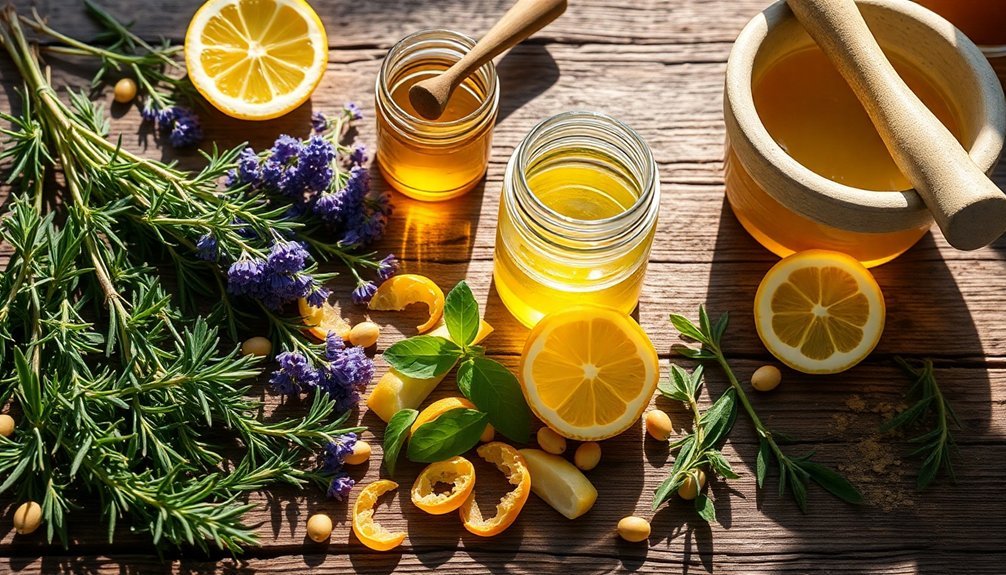
Harnessing the purifying essence of plants, herbal infusions serve as potent foundations for natural cleansers while connecting you to ancient wellness traditions.
Common botanical powerhouses like chamomile and calendula offer anti-inflammatory benefits that soothe irritated skin, while lavender provides gentle antiseptic properties.
To create your own infusion, steep dried herbs for 20-30 minutes to extract their beneficial compounds.
Try rose water for toning, green tea for antioxidant protection, or hibiscus to brighten your complexion. These infusions pair beautifully with castile soap to form effective face washes without harsh chemicals.
You'll find these plant-based cleansers deliver multiple benefits—from antibacterial properties to moisturizing effects—while remaining gentle enough for sensitive skin.
The result is a personalized cleanser that nurtures your skin with nature's own remedies. Ingredients like rose petals and ceylon cinnamon provide not only cleansing properties but also a delicate, smooth taste that enhances the sensory experience.
Balancing Skin Ph With Ancient Plant Knowledge
Throughout millennia of skincare wisdom, our ancestors recognized that plants naturally help maintain the delicate acid mantle of our skin. Your skin thrives at a slightly acidic pH between 4.5 and 5.5, and traditional plant ingredients work harmoniously with this natural balance.
You'll find that incorporating chamomile and aloe vera soothes irritation while tea tree and neem provide antimicrobial protection. Rosehip and jojoba oils regulate sebum production without disrupting your skin barrier.
For formulating cleansers, consider hydrosols – distilled plant waters that naturally balance pH while hydrating. Raw honey, with its average pH of 4.0, helps rebuild the skin's acid mantle while effectively removing dirt and excess oil.
Ancient traditions valued calendula for protection and lavender for calming effects. Modern research confirms what traditional healers knew intuitively: plant extracts like Epilobium Angustifolium and Betula Pendula contain compounds that support your skin's natural pH equilibrium.
Sustainable Harvesting and Preparation of Cleansing Ingredients
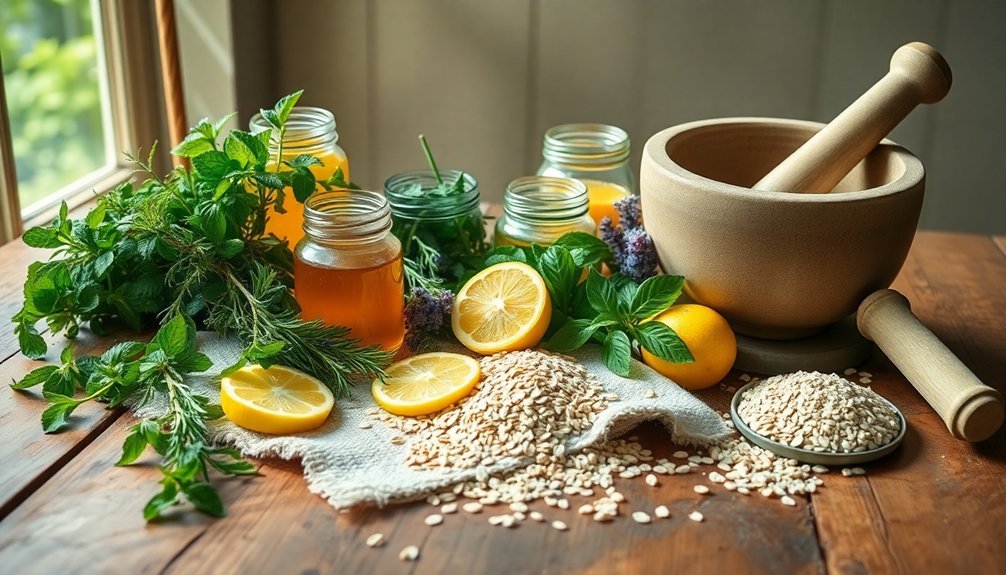
Sustainable harvesting begins with respect for nature's rhythms and regenerative cycles when gathering ingredients for your natural cleansers.
Choose rain-fed crops like guar beans to reduce water usage, and look for ingredients grown through organic farming certified by COSMOS or EU Ecolabel.
When selecting products, prioritize those with farm-to-market transparency, allowing you to understand the sourcing journey.
Support fair trade practices that guarantee farmers receive equitable compensation while preserving local biodiversity.
The Sustainable Guar Initiative exemplifies this approach, teaching farmers practices that improve their livelihoods while protecting ecosystems.
For your formulations, opt for naturally-derived surfactants and polymer-free options that avoid microplastics.
Using concentrated formats and biodegradable packaging further minimizes your environmental footprint while maintaining cleansing efficacy.
When choosing personal care products, it's essential to check ingredients for high naturalness indexes that indicate eco-friendly alternatives to synthetic ingredients.
Essential Tools for the Natural Cleanser Artisan
Creating effective natural cleansers requires specific tools that guarantee precision, safety, and quality in your formulations.
You'll need to invest in precision equipment to confirm your handcrafted products meet consistent standards.
- Measurement Tools – Precision scales (accurate to 0.01g), measuring cups, and spoons are essential for following recipes exactly, particularly when working with potent essential oils.
- Safety Equipment – Always have gloves, protective goggles, and aprons to shield yourself from potential irritants. Keep white vinegar nearby as a neutralizing agent in case you experience accidental lye spills during the soap-making process.
- Mixing Arsenal – Glass rods, spatulas, stick blenders, and whisks help achieve the perfect consistency in your cleansers.
- Storage Solutions – Glass containers, soap molds, and proper labeling supplies confirm your finished products remain fresh and properly identified.
Formulating Customized Cleansers for Different Skin Types
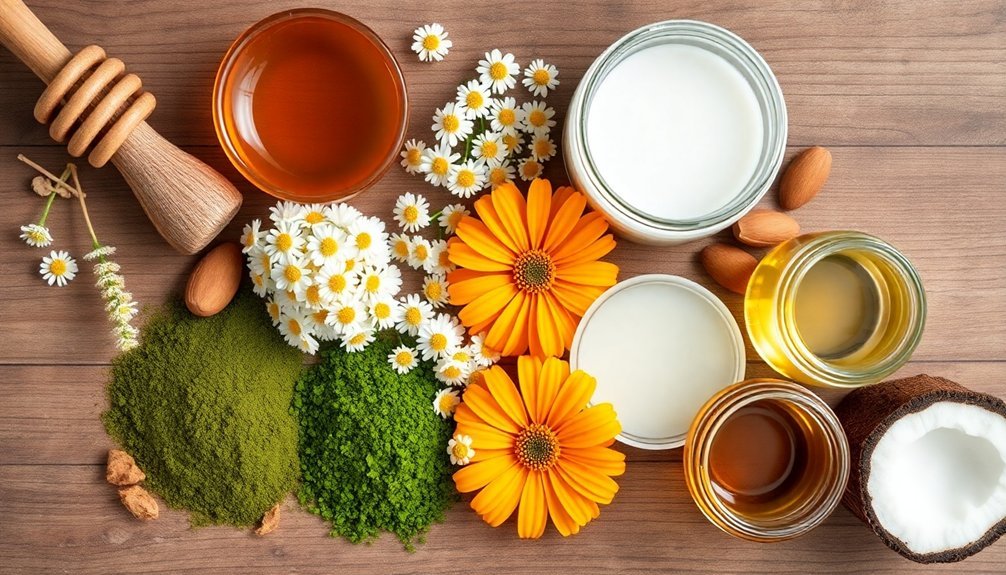
Successful natural cleanser formulation begins with a deep understanding of how different skin types respond to various ingredients.
For dry skin, include jojoba oil and aloe vera to maintain hydration, while oily skin benefits from purifying elements like tea tree oil and rhassoul clay to control sebum production.
When addressing sensitive skin, opt for hypoallergenic, paraben-free ingredients and avoid synthetic fragrances. Instead, use gentle essential oils for natural scent.
For acne-prone skin, incorporate antibacterial components like neem or salicylic acid, while aging skin thrives with antioxidant-rich vitamin E.
Start with simpler formulations before attempting complex recipes, and always verify your cleanser is pH-balanced. Effective cleansing removes impurities and excess oil that can lead to skin problems when left on the skin.
Document your process meticulously to refine formulas, and test thoroughly across different skin types to guarantee safety and effectiveness.
Frequently Asked Questions
How Long Do Homemade Natural Cleansers Typically Last?
Without preservatives, your homemade cleansers have limited shelf life. Oil-based products last 3-6 months, while water-based ones spoil within days. You'll extend longevity by storing them in airtight containers away from light and moisture.
Can I Combine Synthetic Preservatives With Traditional Botanical Ingredients?
Yes, you can combine synthetic preservatives with botanical ingredients. It's actually a common practice that creates synergistic effects, enhancing antimicrobial protection while maintaining the benefits of natural ingredients in your formulations.
Are There Allergen Concerns With Certain Natural Cleansing Ingredients?
Yes, you'll find many natural ingredients can cause allergic reactions. Essential oils, plant-based oils, and even glycerin might trigger redness, itching, or rashes. Always perform patch tests before using new natural products.
How Can I Test Natural Cleansers for Effectiveness?
You can test cleanser effectiveness by checking pH with a meter, conducting microbial tests, evaluating dirt removal, gathering user feedback, and monitoring skin's moisture levels before and after use.
What Ingredient Substitutions Work for Rare or Costly Botanicals?
You can substitute rare or costly botanicals with accessible alternatives like green tea for antioxidants, cucumber extract for anti-inflammatories, honey for humectants, yogurt for glycolic acid, and rosemary extract for preservatives. They're equally effective and budget-friendly.
In Summary
You've now explored the timeless art of natural cleansing. By combining ancient wisdom with your own intuition, you'll create products that truly honor your skin's needs. Remember, you're not just making cleansers—you're participating in a tradition that connects you to generations of healers. Trust your hands, respect your ingredients, and you'll transform your skincare routine into a meaningful ritual worth sharing.

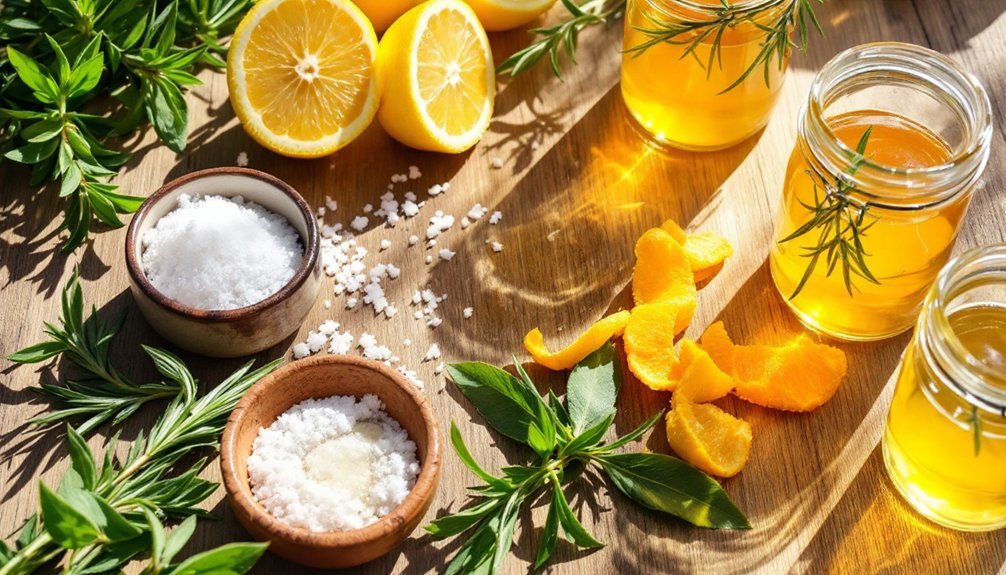



Leave a Reply